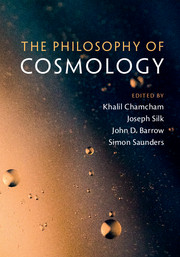Book contents
- Frontmatter
- Contents
- List of Contributors
- Preface
- Acknowledgments
- Part I Issues in the Philosophy of Cosmology
- Part II Structures in the Universe and the Structure of Modern Cosmology
- Part III Foundations of Cosmology: Gravity and the Quantum
- Part IV Quantum Foundations and Quantum Gravity
- 14 Is Time's Arrow Perspectival?
- 15 Relational Quantum Cosmology
- 16 Cosmological Ontology and Epistemology
- 17 Quantum Origin of Cosmological Structure and Dynamical Reduction Theories
- 18 Towards a Novel Approach to Semi-Classical Gravity
- Part V Methodological and Philosophical Issues
- Index
- References
17 - Quantum Origin of Cosmological Structure and Dynamical Reduction Theories
from Part IV - Quantum Foundations and Quantum Gravity
Published online by Cambridge University Press: 18 April 2017
- Frontmatter
- Contents
- List of Contributors
- Preface
- Acknowledgments
- Part I Issues in the Philosophy of Cosmology
- Part II Structures in the Universe and the Structure of Modern Cosmology
- Part III Foundations of Cosmology: Gravity and the Quantum
- Part IV Quantum Foundations and Quantum Gravity
- 14 Is Time's Arrow Perspectival?
- 15 Relational Quantum Cosmology
- 16 Cosmological Ontology and Epistemology
- 17 Quantum Origin of Cosmological Structure and Dynamical Reduction Theories
- 18 Towards a Novel Approach to Semi-Classical Gravity
- Part V Methodological and Philosophical Issues
- Index
- References
Summary
Introduction
Contemporary cosmology includes inflation as one of its central components. It corresponds to a period of accelerated expansion thought to have occurred very early in cosmic history, which takes the universe from relatively generic post Planckian era conditions to a stage where it is well described (with exponential accuracy in the number of e-folds) by a flat Robertson–Walker space-time (which describes a homogeneous and isotropic cosmology).
It was initially proposed to resolve various naturalness problems: flatness, horizons, and the excess of massive relic objects, such as topological defects, that were expected to populate the universe according to grand unified theories (GUT). Nowadays, it is lauded because it predicts that the universe's mean density should be essentially identical to the critical value, a very peculiar situation which corresponds to a spatially flat universe. The existing data support this prediction. However, its biggest success is claimed to be the natural account for the emergence of the seeds of cosmic structure in terms of primordial quantum fluctuations, and the correct estimate of the corresponding microwave spectrum.
This represents, thus, a situation which requires the combined application of general relativity (GR) and quantum theory, and that, moreover, is tied with observable imprints left from the early universe, in both the radiation in cosmic microwave background (CMB), and in the large scale cosmological structure we can observe today. It should not be surprising that, when dealing with attempts to apply our theories to the universe as a whole, we should come face to face with some of the most profound conceptual problems facing our current physical ideas.
In fact, J. Hartle had noted long ago [28] that serious difficulties must be faced when attempting to apply quantum theory to cosmology, although the situations that were envisioned in those early works corresponded to the even more daunting problem of full quantum cosmology, and not the limited use of quantum theory to consider perturbative aspects, which is what is required in the treatment of the inflationary origin of the seeds of cosmic structure. This led him and his collaborators to consider the Consistent Histories framework, which is claimed to offer a version of quantum theory that does not rely on any fundamental notion of measurements, as the favored approach to use in such contexts. We will have a bit more to say about this shortly.
- Type
- Chapter
- Information
- The Philosophy of Cosmology , pp. 330 - 355Publisher: Cambridge University PressPrint publication year: 2017



